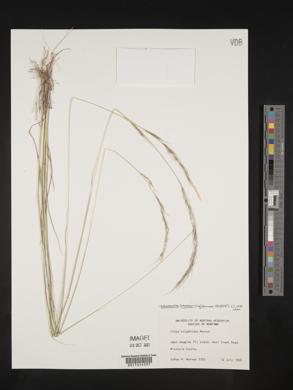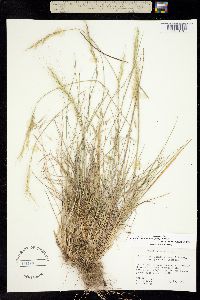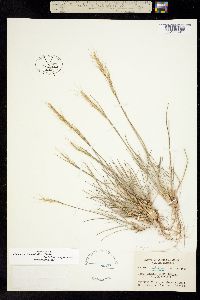Achnatherum lemmonii
|
|
|
|
Family: Poaceae
Lemmon's needlegrass, more...Lemmon's Rice Grass, Lemmon's Needlegrass
[Stipa columbiana var. columbiana Macoun, moreStipa pringlei var. lemmonii Vasey] |
Plants tightly cespitose, not rhizomatous. Culms 15-90 cm tall, 0.7-1 mm thick, glabrous, pubescent, or tomentose; nodes 3-4. Basal sheaths glabrous, pubescent, or tomentose; collars, including the sides, glabrous or sparsely pubescent, hairs shorter than 0.5 mm; basal ligules 0.5-1.2 mm, hyaline, glabrous, truncate to acute; upper ligules to 2.5 mm; basal blades 0.5-1.5 mm wide, folded to convolute, abaxial surfaces smooth, glabrous, adaxial surfaces prominently ribbed, often with 0.3-0.5 mm hairs, sometimes glabrous; upper blades to 2.5 mm wide, otherwise similar to the basal blades. Panicles 7-21 cm long, about 1 cm wide; branches straight, strongly ascending to appressed, longest branches 4-5 cm. Spikelets appressed to the branches. Glumes subequal, 7-11.5 mm; lower glumes 0.9-1.1 mm wide, 4-5-veined; upper glumes 3-veined; florets 5.5-7 mm long, 0.8-1.3 mm thick, fusiform, somewhat laterally compressed; calluses 0.4-1.2 mm, blunt; lemmas coriaceous, evenly pubescent, hairs 0.4-1 mm, apices 1-lobed, lobe about 0.1 mm long, thick, stiff, apical lemma hairs 0.4-0.8 mm; awns 16-30 mm, persistent, (once)twice-geniculate, all segments scab-rous, terminal segment straight; paleas 4.5-6.5 mm, from 3/4 as long as to equaling the lemmas, sparsely to moderately pubescent, hairs not exceeding the apices, veins terminating below the apices, apices flat or pinched; anthers 2.3-3.5 mm, dehiscent, not penicillate. Caryopses 4-5 mm, fusiform. 2n = 34. Achnatherum lemmonii grows in sagebrush and yellow pine associations, from southern British Columbia to California and east to Utah. It has been confused in the past with A. nelsonii; it differs in having narrower leaves, laterally compressed florets with a thick apical lobe, and longer paleas. Dr. David Bogler, USDA NRCS PLANTS Database Perennials, Terrestrial, not aquatic, Stems nodes swollen or brittle, Stems erect or ascending, Stems caespitose, tufted, or clustered, Stems terete, round in cross section, or polygonal, Stem internodes hollow, Stems with inflorescence less than 1 m tall, Stems, culms, or scapes exceeding basal leaves, Leaves mostly basal, below middle of stem, Leaves mostly cauline, Leaves conspicuously 2-ranked, distichous, Leaves sheathing at base, Leaf sheath mostly open, or loose, Leaf sheath smooth, glabrous, Leaf sheath and blade differentiated, Leaf blades linear, Leaf blades very narrow or filiform, less than 2 mm wide, Leaf blades 2-10 mm wide, Leaf blade margins folded, involute, or conduplicate, Leaf blades mostly glabrous, Ligule present, Ligule an unfringed eciliate membrane, Inflorescence terminal, Inflorescence a contracted panicle, narrowly paniculate, branches appressed or ascending, Inflorescence a dense slender spike-like panicle or raceme, branches contracted, Inflorescence solitary, with 1 spike, fascicle, glomerule, head, or cluster per stem or culm, Flowers bisexual, Spikelets pedicellate, Spikelets dorsally compressed or terete, Spikelet less than 3 mm wide, Spikelets with 1 fertile floret, Spikelets solitary at rachis nodes, Spikelets all alike and fertille, Spikelets bisexual, Spikelets disarticulating above the glumes, glumes persistent, Spikelets disarticulating beneath or between the florets, Rachilla or pedicel glabr ous, Glumes present, empty bracts, Glumes 2 clearly present, Glumes equal or subequal, Glumes equal to or longer than adjacent lemma, Glumes 3 nerved, Glumes 4-7 nerved, Lemma coriaceous, firmer or thicker in texture than the glumes, Lemma 5-7 nerved, Lemma body or surface hairy, Lemma apex acute or acuminate, Lemma distinctly awned, more than 2-3 mm, Lemma with 1 awn, Lemma awn 1-2 cm long, Lemma awn 2-4 cm long or longer, Lemma awned from tip, Lemma awn twisted, spirally coiled at base, like a corkscrew, Lemma awn twice geniculate, bent twice, Lemma margins inrolled, tightly covering palea and caryopsis, Lemma straight, Callus or base of lemma evidently hairy, Callus hairs shorter than lemma, Lemma surface pilose, setose or bristly, Palea present, well developed, Palea membranous, hyaline, Palea shorter than lemma, Palea about equal to lemma, Stamens 3, Styles 2-fid, deeply 2-branched, Stigmas 2, Fruit - caryopsis, Caryopsis ellipsoid, longitudinally grooved, hilum long-li near.
|
|
|
|































































































